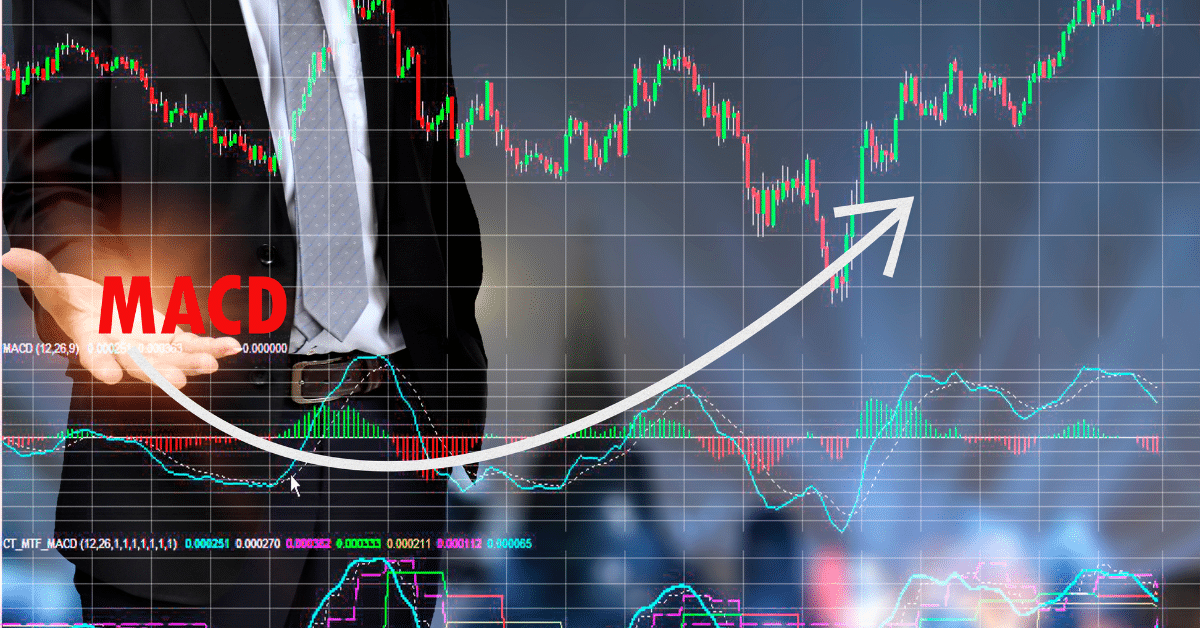Bollinger Bands and MACD, what connects them is that they can be used together as complementary indicators to provide a complete picture of the market conditions. Moving Average Convergence Divergence is a momentum trend-following indicator that shows how two price moving averages relate to one another. It is derived by deducting the 12-period EMA from the 26-period exponential moving average (EMA). A histogram and a signal line, a 9-day EMA of the MACD line, are used to show the difference.

The Bollinger Bands volatility indicator is made up of two standard deviation lines that are displayed two standard deviations apart from a moving average (usually the 20-day SMA). The bands expand when the market is volatile and contract when the market is less volatile.
While the MACD provides information about momentum and trend, Bollinger Bands indicate an asset’s volatility and potential overbought/oversold conditions. For example, if the price is near the upper Bollinger Bands and the MACD histogram is positive, it may indicate an overbought market. On the other hand, if the price is close to the lower Bollinger Band and the MACD histogram is negative, the market may be oversold.
How can a trader decide between Bollinger Bands and MACD?
The choice between Bollinger Bands and MACD (Moving Average Convergence Divergence) will depend on several factors, including:
- Trading style: Different traders have different preferences for the type of information they receive from technical indicators. Bollinger Bands are best suited for traders prioritising volatility analysis and overbought/oversold conditions, while MACD is best suited for traders prioritising trend analysis and momentum.
- Market outlook: Traders with a bullish outlook may find Bollinger Bands more helpful in identifying overbought conditions, while traders with a bearish outlook may find MACD more helpful in identifying trend changes.
- Market conditions: Different market conditions may call for the use of different indicators. For example, Bollinger Bands may be more useful in a ranging market, while MACD may be more useful in a trending market.
- Trading strategy: Different trading strategies may require different types of technical analysis. For example, swing traders may find Bollinger Bands more helpful in identifying entry and exit points, while day traders may find MACD more useful for making intraday trades.

In addition, traders should also consider their level of experience and comfort with technical analysis when choosing between Bollinger Bands and MACD. Both indicators have strengths and weaknesses, so it’s best to experiment with Bollinger Bands and MACD to determine which works best for your individual trading style and goals.
How do you use Bollinger Bands with MACD?
Traders can gain insights into market movements and possible trading opportunities by combining Bollinger Bands and MACD indicator. Bollinger Bands, with their centre band, higher and lower bands, and upper and lower bands, aid in identifying periods of high or low volatility.
When the bands contract, implying little volatility, and the MACD histogram has low or near-zero values, it indicates a consolidation period. Widening bands and bigger swings in the MACD histogram, on the other hand, suggest increased volatility, perhaps indicating a breakout or trend. Traders also look for divergences between price and the MACD line, and Bollinger Bands can assist in corroborating these divergences.
Additionally, Bollinger Bands are used to confirm breakouts. When the price is near the upper Bollinger Band and the MACD line shows bullish momentum, it suggests a bullish breakout and vice versa. It’s important to consider other factors, such as support and resistance levels, volume, and overall market conditions to make informed trading decisions when using these indicators together.
What are some common trading strategies that involve Bollinger Bands and MACD?
Bollinger Squeeze with MACD: When the Bollinger Bands contract shows low volatility, it may indicate that a spike in volatility is possible. Traders often wait for a Bollinger Squeeze, in which the bands are closely compressed, and then catch a breakthrough. They can utilize the MACD histogram to validate the breakout direction. If the histogram demonstrates bullish momentum (above the zero line or crosses above the signal line), it can be used to predict a long trade’s entry. In contrast, bearish momentum (below the zero line or passing below the signal line) might indicate a potential short position.
Divergence Trading: Traders often look for divergences between the price and the MACD line to detect possible trend reversals. When a bullish divergence develops, traders may consider purchasing when the price recovers. Similarly, a bearish divergence might suggest a probable downside trend reversal, urging traders to investigate short-selling alternatives. Bollinger Bands can be used to support these divergences. If a bullish or bearish divergence occurs at the lower or higher Bollinger Band, it might give additional confirmation for future reversal trades.
Trend Following: Bollinger Bands may also spot trends and back up trend-following methods. A strong bullish trend is indicated when the price constantly trades around the upper Bollinger Band and the MACD line is above the signal or zero lines. Traders at this stage may want to consider taking long positions and following the trend until signs of a reversal or a bearish divergence. In contrast, a strong bearish trend is indicated when the price constantly trades towards the lower Bollinger Band and the MACD line is below the signal or zero lines. Short-selling chances may be considered by traders looking to profit from the downward trend.
Breakout Trading: Bollinger Bands can aid in the identification of future breakouts from a range-bound market. When the price is close to or above the upper Bollinger Band, it indicates a bullish breakout. Traders at this point consider establishing long bets to capitalize on the rising trend. When the price is close to the lower Bollinger Band and breaks below it, it indicates a bearish breakout. To profit from the downward momentum, traders may examine short-selling chances. MACD may be used to corroborate the momentum behind the breakout, increasing the likelihood of success.
What is the difference between Bollinger Bands and MACD?
Bollinger Bands:
- BB is a volatility indicator that consists of a simple moving average (SMA) and two standard deviation lines plotted two standard deviations away from the SMA.
- Bollinger Bands help traders identify overbought and oversold conditions and potential trend reversals.
- Bollinger Bands measure volatility by plotting the bands further away from the SMA when the market is volatile and closer when the market is less volatile.
Moving Average Convergence Divergence:
- MACD is a momentum trend-following indicator comprising a histogram, two exponential moving averages (EMAs), and other components.
- MACD helps traders identify trends, momentum and potential trend changes.
- MACD calculates the difference between a fast EMA and a slow EMA and plots it as a histogram, with bullish and bearish signals generated when the histogram crosses the signal line.
How to use Bollinger Bands for day trading?
Bollinger Bands can be used for day trading in several ways, including:
Identifying overbought/oversold conditions: An asset may be overbought or oversold and have a possible reversal if its price swings outside the upper or lower Bollinger Band.
Mean reversion trades: If the price of an asset moves away from its mean (the 20-day SMA) and returns to it, traders can profit from mean reversion by purchasing at the lower band and selling at the upper band.
Trend identification: If the price of an asset is trading within the bands, it may indicate a sideways or range-bound market. If the price trends are outside the bands, it may indicate an uptrend or downtrend.
Breakout trades: If the price of an asset breaks through the upper or lower band, it may signal a continuation of the trend and a potential for a breakout trade.
It’s important to note that Bollinger Bands should not be used in isolation and should be combined with other technical indicators and analysis techniques to make informed trading decisions. Traders should also consider market fundamentals and news events that may impact the asset’s price.

Bollinger Band patterns:
There are several Bollinger Band patterns that traders use to make trading decisions:
- Squeeze: The Bollinger Bands squeeze together, indicating a period of low volatility. This can be a potential signal for a future trend change.
- W-Bottom: This pattern occurs when security makes two lows below the lower Bollinger Band and then rallies above the lower band. This pattern can indicate a potential reversal from a downtrend to an uptrend.
- M-Top: This pattern occurs when security makes two highs above the upper Bollinger Band and then drops below the upper band. This pattern can indicate a potential reversal from an uptrend to a downtrend.
- Bollinger Bands Expansion: If the Bollinger Bands are consistently expanding, it can indicate increased volatility and a potential trend change.
- Bollinger Bands Contraction: If the Bollinger Bands are consistently contracting, it can indicate reduced volatility and a potentially ranging market.
It’s important to note that these patterns are not foolproof and should be used in collaboration to make trading decisions. Traders should also consider market fundamentals and other technical indicators and apply a risk management strategy to their trades. Additionally, traders should always consider the historical performance of a particular pattern and its reliability for a specific security before making a trade.
Closing Thoughts
Finally, while Bollinger Bands and MACD are important technical indicators utilised in trading, they serve distinct purposes. Bollinger Bands help identify high or low volatility periods, confirm divergences, and indicate prospective breakouts. MACD, on the other hand, uses the relation between two moving averages to identify momentum and trends. While Bollinger Bands give information about market volatility and probable reversals, MACD focuses on the intensity and direction of price moves. These indicators may be helpful tools when utilised correctly and with other analysis approaches.
Traders should consider each indicator’s unique characteristics and analyse their strengths and limitations when incorporating them into their trading strategies. By combining Bollinger Bands and MACD, traders can gain a more comprehensive understanding of market dynamics and make more informed trading decisions.
How to Use Moving Average Convergence Divergence?

